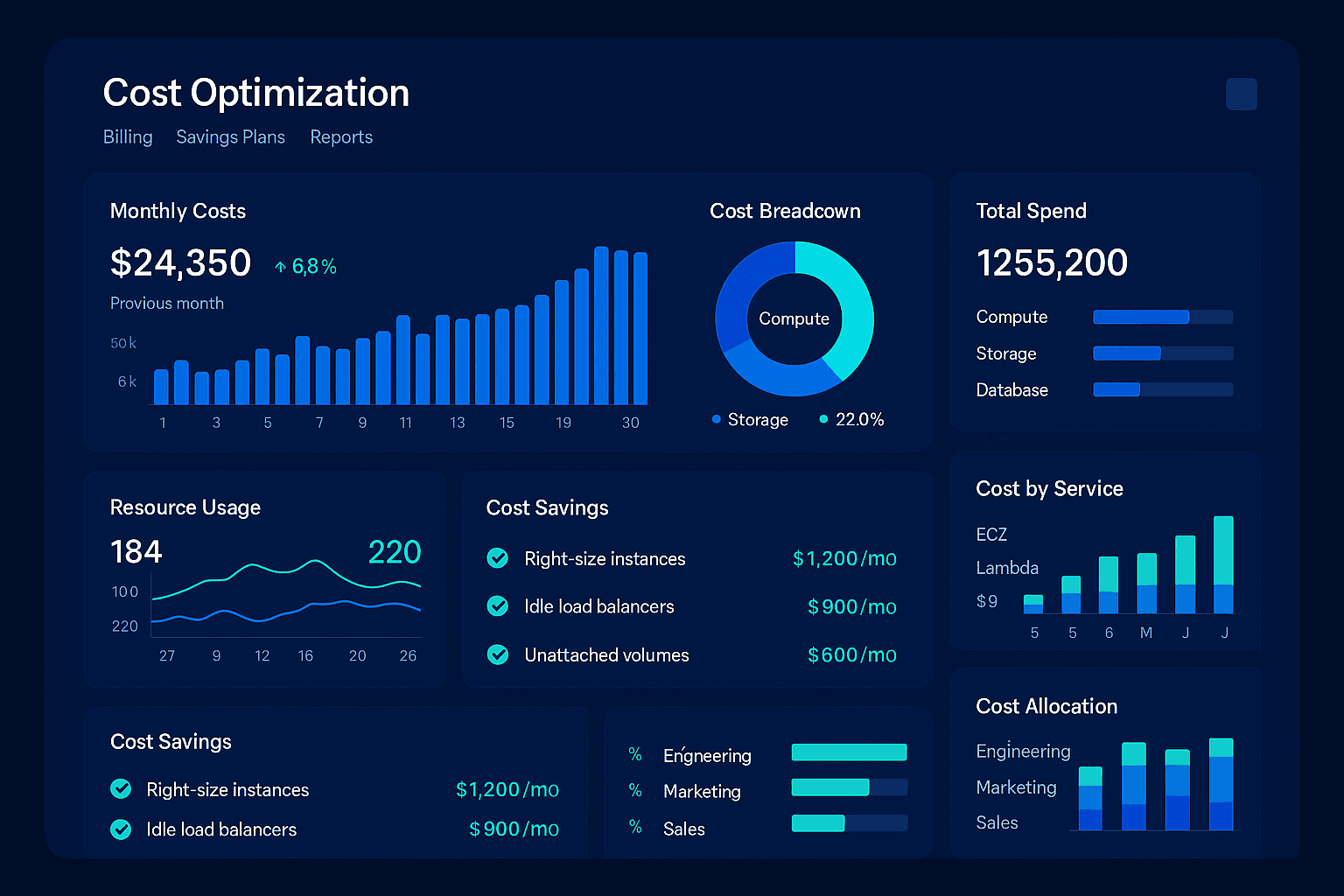AWS Cost Optimization Strategies That Actually Work
Practical AWS cost optimization guide covering right-sizing, reserved instances, storage optimization, network costs, serverless vs containers, automated monitoring, and FinOps practices with real case studies

AWS cost optimization is often treated as an afterthought, leading to cloud bills that spiral out of control and erode the business value of cloud adoption. The reality is that most organizations waste 30-50% of their AWS spend on unused resources, oversized instances, and inefficient architectures.
This comprehensive guide cuts through the noise to deliver proven, data-driven strategies that deliver real savings. Based on analysis of hundreds of AWS cost optimization engagements, we'll explore the tactics that consistently produce results—and the common mistakes that sabotage cost reduction efforts.
The AWS Cost Crisis
Average AWS Waste
Unused or underutilized resources
Global Cloud Waste (2023)
Across all cloud providers
YoY Cost Growth
Without optimization efforts
Common Cost Optimization Mistakes and Misconceptions
Before diving into optimization strategies, it's crucial to understand the pitfalls that derail most cost reduction initiatives. These misconceptions lead to wasted effort and missed opportunities for significant savings.
Critical Mistakes to Avoid
Strategic Errors
- One-Time Optimization: Treating cost optimization as a project rather than ongoing practice
- Performance Over Cost: Assuming bigger instances always mean better performance
- Reserved Instance Misconceptions: Buying RIs without usage analysis
- Ignoring Data Transfer: Overlooking network costs that can reach 15% of total spend
Tactical Mistakes
- Manual Monitoring: Relying on monthly bill reviews instead of automated alerts
- Lack of Tagging: Poor resource tagging preventing accurate cost allocation
- Storage Neglect: Ignoring storage lifecycle policies and unused volumes
- Team Silos: Optimization efforts isolated to ops teams without developer involvement
Success Principle
Effective cost optimization requires cultural change, not just technical implementation. Organizations that achieve 40%+ savings treat cost optimization as a shared responsibility across development, operations, and business teams.
Right-Sizing Instances and Reserved Instance Strategies
Instance optimization represents the largest opportunity for immediate cost savings, typically delivering 20-40% reductions in compute costs through strategic right-sizing and intelligent reserved instance purchasing.
Right-Sizing Methodology
Analysis Framework
Reserved Instance Strategy
- Baseline Coverage: Start with 60-70% RI coverage for stable workloads
- Convertible RIs: Use for workloads with potential architecture changes
- Savings Plans: Prefer for containerized and serverless workloads
- Spot Integration: Combine with Spot instances for 70-90% savings on fault-tolerant workloads
Storage Optimization and Lifecycle Management
Storage costs often represent 20-30% of total AWS spend, yet they're frequently overlooked in optimization efforts. Strategic storage management can reduce costs by 50-80% while improving performance and compliance.
Storage Optimization Framework
S3 Optimization
- Intelligent Tiering: Automatic movement between access tiers
- Lifecycle Policies: Automated transition to IA, Glacier, Deep Archive
- Incomplete Multipart Cleanup: Remove failed upload fragments
- Duplicate Detection: Identify and eliminate redundant objects
EBS & EFS Optimization
- Unattached Volume Cleanup: Identify and remove orphaned EBS volumes
- GP3 Migration: Upgrade from GP2 for 20% cost savings
- Snapshot Management: Automated cleanup of old snapshots
- EFS Infrequent Access: Enable IA for 85% savings on rarely accessed files
Network Cost Reduction Techniques
Network costs are often the most overlooked component of AWS bills, yet they can represent 10-25% of total spend. Understanding data transfer patterns and implementing strategic network optimization can yield substantial savings.
Network Optimization Strategies
Data Transfer Optimization
- CloudFront CDN: Reduce origin data transfer by 60-80%
- Regional Optimization: Keep data and compute in same AZ/region
- Compression: Enable gzip/brotli compression for 70% reduction
- VPC Endpoints: Eliminate NAT Gateway costs for AWS services
Architecture Patterns
Serverless vs. Container Cost Considerations
The choice between serverless and containerized architectures has significant cost implications that extend beyond simple compute pricing. Understanding the total cost of ownership helps optimize both performance and spend.
Cost Analysis Framework
Serverless (Lambda) Advantages
- Zero Idle Costs: Pay only for actual execution time
- Automatic Scaling: No over-provisioning required
- Operational Overhead: Reduced management costs
- Optimal for: Event-driven, sporadic, or unpredictable workloads
Container (ECS/EKS) Advantages
- Predictable Costs: Fixed pricing for consistent workloads
- Resource Efficiency: Better utilization for long-running processes
- No Cold Starts: Consistent performance characteristics
- Optimal for: Steady-state, high-throughput, or latency-sensitive workloads
Real Case Studies with Specific Savings Achieved
These real-world case studies demonstrate the tangible impact of systematic AWS cost optimization across different industries and use cases.
E-commerce Platform
SaaS Startup
Aggregate Impact
Total Monthly Savings
Across case studies
Average Cost Reduction
Within 3-6 months
Annual Savings Impact
Sustained over 12 months
Ready to Optimize Your AWS Costs?
Secure Cloud Networks has helped organizations save over $50M in AWS costs through proven optimization strategies. Our expert team can conduct a comprehensive cost assessment and implement optimization strategies that deliver measurable results within 90 days.